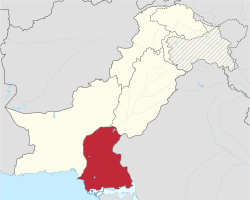
Back Sindh ACE السند (إقليم) Arabic Sindh AST Sind əyaləti Azerbaijani سیند ایالتی AZB Сінд Byelorussian Сынд BE-X-OLD Синд Bulgarian सिंध Bihari সিন্ধু প্রদেশ Bengali/Bangla
Sindh
| |
|---|---|
| Province of Sindh | |
|
| |
| Etymology: Sind | |
| Nickname(s): Mehran (Gateway), Bab-ul-Islam (Gateway of Islam) | |
 Location of Sindh in Pakistan | |
| Coordinates: 26°21′N 68°51′E / 26.350°N 68.850°E | |
| Country | |
| Established | 1 July 1972 |
| Before was | Part of West Pakistan |
| Capital and largest city | Karachi |
| Administrative Divisions | |
| Government | |
| • Type | Self-governing province subject to the federal government |
| • Body | Government of Sindh |
| • Governor | Kamran Tessori |
| • Chief Minister | Murad Ali Shah |
| • Chief Secretary | Dr Fakhre Alam (BPS-22 PAS) |
| • Legislature | Provincial Assembly |
| • High Court | Sindh High Court |
| Area | |
| • Total | 140,914 km2 (54,407 sq mi) |
| • Rank | 3rd |
| Elevation | 173 m (568 ft) |
| Population | |
| • Total | 55,696,147 |
| • Rank | 2nd |
| • Density | 395/km2 (1,020/sq mi) |
| Demonym | Sindhi |
| GDP (nominal) | |
| • Total | $86 billion (2nd)[a] |
| • Per Capita | $1,997 (3rd) |
| GDP (PPP) | |
| • Total | $345 billion (2nd)[a] |
| • Per Capita | $7,209 (3rd) |
| Time zone | UTC+05:00 (PKT) |
| ISO 3166 code | PK-SD |
| Languages | |
| Notable sports teams | Sindh cricket team Karachi Kings Karachi United Hyderabad Hawks Karachi Dolphins Karachi Zebras |
| HDI (2021) | 0.517
Low |
| Literacy rate (2020) | 61.8% |
| Seats in National Assembly | 75 |
| Seats in Provincial Assembly | 168[5] |
| Divisions | 7 |
| Districts | 30 |
| Tehsils | 138 |
| Union Councils | 1108[6] |
| Website | sindh.gov.pk |
| Part of a series on |
| Sindhis |
|---|
 |
 Sindh portal |
Sindh (/ˈsɪnd/ SIND; Sindhi: سِنْڌ; Urdu: سِنْدھ, pronounced [sɪndʱə]; abbr. SD, historically romanized as Sind) is a province of Pakistan. Located in the southeastern region of the country, Sindh is the third-largest province of Pakistan by land area and the second-largest province by population after Punjab. It is bordered by the Pakistani provinces of Balochistan to the west and north-west and Punjab to the north. It shares an International border with the Indian states of Gujarat and Rajasthan to the east; it is also bounded by the Arabian Sea to the south. Sindh's landscape consists mostly of alluvial plains flanking the Indus River, the Thar Desert of Sindh in the eastern portion of the province along the international border with India, and the Kirthar Mountains in the western portion of the province.
The economy of Sindh is the second largest in Pakistan after the province of Punjab; its provincial capital Karachi is the most populous city in the country as well as its main financial hub. Sindh is home to a large portion of Pakistan's industrial sector and contains two of the country's busiest commercial seaports: Port Qasim and the Port of Karachi. The remainder of Sindh consists of an agriculture-based economy and produces fruits, consumer items and vegetables for other parts of the country.[7][8][9]
Sindh is sometimes referred to as the Bab-ul Islam (transl. 'Gateway of Islam'), as it was one of the first regions of the Indian subcontinent to fall under Islamic rule.[10][11] The province is well known for its distinct culture, which is strongly influenced by Sufist Islam, an important marker of Sindhi identity for both Hindus and Muslims.[12] Sindh is prominent for its history during the Bronze Age under the Indus Valley civilization, and is home to two UNESCO-designated World Heritage Sites: the Makli Necropolis and Mohenjo-daro.[13]
- ^ "Announcement of Results of 7th Population and Housing Census-2023 (Sindh province)" (PDF). Pakistan Bureau of Statistics (www.pbs.gov.pk). 5 August 2023. Retrieved 25 November 2023.
- ^ "GDP OF KHYBER PUKHTUNKHWA'S DISTRICTS" (PDF). kpbos.gov.pk.
- ^ "Report for Selected Countries and Subjects".
- ^ "Sub-national HDI - Subnational HDI - Global Data Lab". Globaldatalab.org. Retrieved 5 June 2022.
- ^ "Welcome to the Website of Provincial Assembly of Sindh". www.pas.gov.pk. Archived from the original on 14 December 2014. Retrieved 24 July 2009.
- ^ "LgdSindh - News Blog". LgdSindh. Archived from the original on 16 June 2019. Retrieved 5 September 2006.
- ^ Staff reporter (9 March 2014). "Sindh must exploit potential for fruit production". The Nation, 2014. The Nation. Retrieved 29 May 2015.
- ^ Markhand, Ghulam Sarwar; Saud, Adila A. "Dates in Sindh". Proceedings of the International Dates Seminar. SALU Press. Retrieved 29 May 2015.
- ^ Editorial (3 September 2007). "How to grow Bananas". Dawn News, 2007. Dawn News. Retrieved 29 May 2015.
- ^ Quddus, Syed Abdul (1992). Sindh, the Land of Indus Civilisation. Royal Book Company. ISBN 978-969-407-131-2.
- ^ JPRS Report: Near East & South Asia. Foreign Broadcast Information Service. 1992.
- ^ Judy Wakabayashi; Rita Kothari (2009). Decentering Translation Studies: India and Beyond. John Benjamins Publishing. pp. 132–. ISBN 978-90-272-2430-9.
- ^ "Properties inscribed on the World Heritage List (Pakistan)". UNESCO. Retrieved 14 July 2016.
Cite error: There are <ref group=lower-alpha> tags or {{efn}} templates on this page, but the references will not show without a {{reflist|group=lower-alpha}} template or {{notelist}} template (see the help page).







